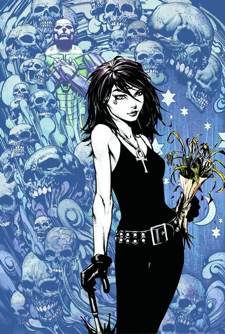Welcome to Wednesday Comics Pull-List, here on Tor.com! Every week we post reviews of a select handful of this week’s comic releases. From those reviews, we let you know what we would pull for keeps.
This week’s batch includes:
- Action Comics #894
- Avengers #6
- Avengers vs. Pet Avengers #1 (of 4)
- Captain America: Patriot #3 (of 4)
- Detective Comics #870
- Dracula: The Company of Monsters #3
- Incognito: Bad Influences #1
- Insane Jane—Avenging Star #1
- JLA/The 99 #1 (of 6)
- The Justice Society of America #44
- Terminator: 1984 #2 (of 3)
- Wonder Woman #604
We took a dive into team books this week and came up confused and unhappy. Luckily, Death, Terminators, and psychopaths were there to cheer us up.
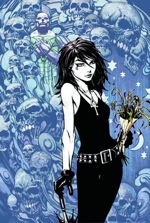 Action Comics #894
Action Comics #894
Written by Paul Cornell
Art by Pete Woods
(DC Comics)
Pull: Yes. I fell for it completely.
Chris says: Oh, what a tease Death is.
The crossover of Death from the Sandman comics series/universe into the DC Universe is not one that is often (maybe not ever?) made, despite the fact that Death is everywhere to every thing. Paul Cornell’s use of her in his current Lex Luthor storyline is notable on that alone.
It’s more notable in that Cornell didn’t strictly need to use Death to accomplish what she does in this issue, although this issue would have been far less potent had Cornell not done so. Lex Luthor as a character in the DC Universe has been portrayed as an unstoppable force for many years now, and few depictions of Death carry the weight that Neil Gaiman’s character does. Gaiman’s Death is charming, doting, anything you need her to be. She’s also a completely immovable object. In a medium of fiction where the dead return at a constant pace, she is genuinely final.
I was hoping for more of that conflict to play out in this issue, though. It gets sidestepped for larger developments in the storyline, and you kick yourself a bit for that, because now you have to know what else is happening in this arc. Which means that, from a marketing perspective, the appearance of Death successfully suckered me into following this title even though I knew that’s what it was supposed to do. (It certainly helps that Paul Cornell is a consistently engaging writer.) Well played, that. You absolutely finish this issue wanting more.
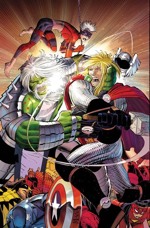 Avengers #6
Avengers #6
Written by Brian Michael Bendis
Art by John Romita Jr.
(Marvel Comics)
Pull: No. A messy and unsatisfying conclusion.
Chris says: Marvel has put its books through several different ringers over the years. With the conclusion of Siege it appeared that they were finally going to settle down and let their books stand on their own without derailing storylines with constant crossovers. Towards that end, I’ve been curious about the books under the “New Heroic Age” banner, but also cautious. Avengers #6, by longtime Avengers writer Brian Michael Bendis and artist John Romita Jr., concludes the first story arc of this new direction.
Unfortunately, it concludes with the looming threat of another big event down the line. ARGH. Further, that looming threat is one that’s played itself out in the Marvel Universe and Avengers titles before, so reading this issue felt doubly defeating.
In addition to this, the issue just feels messy. There’s a lot of plot to keep track of, but there’s a reset button involved here, so it ends up feeling like the story itself just gave up. Usually Bendis is great at providing engaging characters when a plot is weak, but the vitality, humanity, and personal conflict that Bendis so expertly brought to the Avengers line isn’t present in this issue.
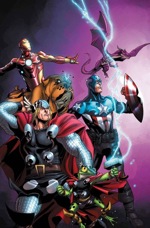 Avengers vs. Pet Avengers #1 (of 4)
Avengers vs. Pet Avengers #1 (of 4)
Written by Chris eliopoulos
Art by Ig Guara
(Marvel Comics)
Pull: IN THE AGE OF DRAGONS, I’d still say no. – Annie
But the dragons are so cute! Lockheed for the win! I say yes. – Chris
Annie says: I knew right off the bat when choosing this comic that it was going to go one of two ways: the comic could be campy and sweet and turn out to be one of those things that you don’t really regret reading or it was going to be mind-numbingly awful. The phrase “an age of DRAGONS!” is used on the first page. I think you know where this is going.
Allegedly, 4500 years ago was AN AGE OF DRAGONS and, apparently, that pissed off the human race so we started killing them off to the point of extinction. Fortunately (maybe?), some nice human wanted to save the dragons and gave one of them, Fin Fang Foom, a sleeping pill that would cause him to sleep for centuries, therefore sparing his life. Science tells us that when an animal hibernates for an extended period of time, they wake up pretty grouchy and definitely hungry. I guess in all of the awe and wonder of the AGE OF DRAGONS no one thought about how unhappy Fin Fang was going to be. But, man, was he pissed. So pissed, in fact, that Fin Fang Foom turned Iron Man, Thor, and Captain America into frogs. Frogs, who have the mental capability to summon the Pet Avengers to somewhere in the South Pacific. The Pet Avengers are made up of a dragon (though this one isn’t as ornery), a sabretoothed tiger, a hawk, a dog, a cat, a frog (who sort of serves as the leader of the group), and a gigantic teleporting dog. This is what I had to endure this morning, kids.
The dialogue was campy but not enough to make reading this bearable. The artwork was great but for 30+ pages, I’m looking at animals, who can talk, fight crime and teleport? And all of the humans who interact with them don’t say anything about it. Sabretooth tigers have been extinct for how long and yet, no one is saying anything about seeing one in the park? At one point a police officer actually thanks the group of super animals without thinking twice about it. I’m all for fun, totally unrealistic plotlines but good grief, really? This is going to be a four part series? There wasn’t any other direction to go in? Really?
Chris says: I had pretty much the opposite reaction that Annie did. I found the camp level in Pet Avengers to be just the right amount of charming and didn’t mind the various implausibilities. The art is something Annie and I agree on, at least. It’s unexpectedly gorgeous for a title centered on animals. The final page, with Lockheed staring down Fin Fang Foom, is Fenominal*.
*Sorry, I had to.
I thought Pet Avengers struck a great balance between out and out ridiculousness and genuine tension. Which is really not easy to do when faced with Frog Thor and Lockjaw, a slobbery moon puppy.
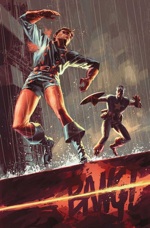 Captain America: Patriot #3 (of 4)
Captain America: Patriot #3 (of 4)
Written by Karl Kesel
Art by Mitch Breitweiser
(Marvel Comics)
Pull: Yes—if you’ve already been picking the series up, there’s no need to stop. And if you haven’t, start to keep your eyes peeled for the trade in a few months; the series has stayed strong, and only a real disappointment next month could ruin it now!
Matt says: The third issue of Karl Kesel and the Breitweisers’ Patriot miniseries is out this week, and it’s both action-packed and a bit of a lull before the final act. The first issue saw Jeff Mace become the Patriot and then take up the mantle of Captain America after the war. The second issue started to delve into important issues surrounding the role of a symbol—and especially what it means to be a symbol of patriotism during peacetime. This month, Kesel puts most of the larger themes on the backburner as Cap pursues the people who shot Bucky. As with the first two issues, this one works nicely as a stand-alone; Cap tracks down and deals with the shooter over the course of these 22 pages, and the cliffhanger simply sets up next month’s story rather than failing to resolve this one. It’s a model I’d like to see more comics follow; give me a good, complete story for my four bucks, and I’ll be happy to come back for next month’s tale! The fact that these four issues will also build a mini-series, complete with complex themes and character development, is how you know that Kesel is really mastering his craft. (That said, issue 3 really delves into another aspect of the writing craft: Kesel really pulls out all the stops with 1940s slang, and the already cinematic book really starts to feel like a “talkie”…!)
If the larger issues have been put temporarily on the backburner, they have not for all that ceased to be the larger issues. The question still stands: what is the role of a symbol of patriotism in peacetime? What does it mean to stand for “America” as the country is divided against itself? How does America’s symbol inspire hope, as the country sinks into the paranoia of the Cold War? Mace’s Captain gives us the same disappointing answer we’ve been hearing since the dawn of superheroes, here: “I don’t see where making our streets safe is any less patriotic than making our shores safe.” And so nationalism joins forces with the police state, as patriotism blurs the lines between law and order and vigilantism. Captain America, symbol of our national ideals, will now begin to fight “the enemy within,” even as Hoover’s paranoid FBI starts to question whether or not Jeff Mace himself is one of those enemies. The paranoia is heating up for the last issue; I, for one, look forward to seeing how Kesel and company resolve things.
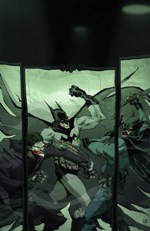 Detective Comics #870
Detective Comics #870
Written by David Hine
Art by Scott McDaniel
(DC Comics)
Pull: Don’t you want to know how it ends?! Yes! Of course you do!
Annie says: Issue #870 is part four of the Imposter Battle going on in Gotham and if you remember from issue #869, Winslow Heath had thrown a fair for Gotham in an attempt to calm everyone down and divert the attention away from the ongoing imposter warfare. This proves to be successful when thousands of Gotham citizens show up at the fairgrounds with hopes of having some good, safe, clean fun.
Of course, that’s not how it ends up. When the fair has reached its capacity, Imposter Joker releases Joker’s laughing gas and, as Batman so eloquently put it, “the crowd went wild!” The entire fairground erupts in chaos. There are imposter Joker’s and Batman’s (Batmen?) literally everywhere entangled in violence. Some of the panels for these fights scenes include so many Batmans and Jokers that the best way to describe it is to liken it to a Where’s Waldo book; so much black, purple and green that your eyes aren’t really sure where to go. Scott McDaniel definitely creates chaos in his artwork and it really comes across that way while you’re reading. Batman (the original) makes his way through the masses to try and find Winslow who agrees to meet him in the House of Mirrors.
Why is it that everything always happens in the house of mirrors? I don’t partake in fairs all that often but when I do, I usually avoid the house of mirrors based solely on the fact that you never really know what is going on in there. Anyway, Batman goes to the House of Mirrors in hopes of confronting Heath but then, SPOILER ALERT, he finds out that Heath is both Imposter Joker AND Imposter Batman and the whole reason he started this warfare was because he believes Batman himself is responsible for all of the bad things that happen to Gotham, and on a personal level, to himself.
The psychology in this comic to explain why it is that Winslow Heath is all sorts of crazy was pretty brilliant but has definitely been done before. There is all sorts of misplaced blame going on and while it’s always suspenseful and fun to read, it reminds me too much of every other crime drama out there. You know when you’re watching Law & Order and it’s the last five minutes and the detectives have the suspect in the interrogation room and, even though they’ve spent the entire episode convincing me that they are innocent, all of a sudden their eyes get low and it’s as if they’ve just decided to unleash their crazy and confess to killing that taxi driver? It’s exactly like that but in a different media. But overall, I’ve got no complaints. It’s a strong ending to a great four-part series.
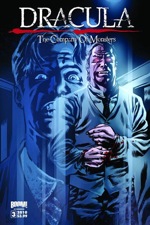 Dracula: The Company of Monsters #3
Dracula: The Company of Monsters #3
Written by Kurt Busiek & Daryl Gregory
Art by Scott Godlewski
(Boom! Studios)
Pull: If you liked the first two, absolutely. Do it.
Annie says: In the last issue, we were given more information regarding Dracula and where his origins of evil sprouted from. This issue, we’re given another history lesson but I was having a real issue figuring out who the narrator was and what their relationship to the Stefanescu family is. In the last three issues, the comics start off with a brief history lesson, though in this issue “history” is considered anything that happened two weeks ago, and then the authors dive into where the story left off last time. It’s a pretty good system as it helps to keep readers interested and engaged in who these characters are and where they come from but at the same time, it’s not necessarily good for clarity.
I tend to forget about this comic until it shows up on the pull list but it is such a good story. Two weeks ago, the Stefanescu family was out in the woods, hunting vampires and, unfortunately, Emil Stefanescu was mauled by a wolf. I’m not sure if it was a werewolf or just a regular wolf but, he was mauled. So there’s that. No idea where that plays into the story but, I imagine that will be explained in later issues.
Cut to present day, we find Evan in the basement of his Uncle’s vampiric hideout talking to Dracula through what he so adequately describes as an “aquarium.” Dracula has been fitted with a device that features spring-loaded ash stakes and shielded crucifixes so that in the event that he does escape from the glass case of emotion, he can be taken down immediately. It would seem that Evan and Dracula get on pretty well and Evan begins to trust him, as much as anyone can trust anything they just resurrected with 900 gallons of goat blood. Against his uncle’s wishes, Evan lets Dracula out of the tank. Of course, he does this just as his uncle is walking into the basement and then, we’re hit with a total maniacal twist. You’ll have to pick it up to find out what it is because I, obviously, cannot tell you. I will tell you, though, that it’s well worth it.
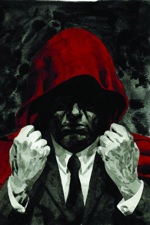 Incognito: Bad Influences #1
Incognito: Bad Influences #1
Written by Ed Brubaker
Art by Sean Phillips
(Marvel Comics)
Pull: Yes! A great follow-up to a fantastic first series. If you haven’t been picking up Incognito, do yourself a favor and grab the first trade at the same time!
Matt says: The long-awaited first issue of the follow-up to last year’s Incognito—Ed Brubaker’s and Sean Phillips’s love letter to pulp comics heroes—drops this week, and it manages to simultaneously stand the first series on its head while being everything you liked about that series! The first Incognito series, you’ll recall—and if you haven’t read it, it’s well worth picking up the trade, which is already out—followed Zack Overkill, a former supervillain who has entered the Witness Protection Program and is forced to suppress his powers and live the tedious life of a normal person. Accidentally discovering a way to get his powers back, Overkill starts to play the role of superhero, just for something to do. Given the opportunity to be a full-time hero (and not have to suppress his powers anymore), Overkill signs on with the good guys at the end of the first series. And so Brubaker’s tale has been about the situations, environmental factors, and influences that make a bad person go “good.” Incognito: Bad Influences, as the title suggests, gives this theme a bit of a spin; this time around, Overkill (now working for the S.O.S. while living under the secret identity “Zack Overton”) is going to be pitted against Simon Slaughter, an under-cover S.O.S. agent who has been pretending to be a bad guy for so long that he’s (allegedly) “gone native.”
Brubaker’s talent for writing noir pulp characters is not wasted here, and the second series already promises to delve further into the existentialist themes that made the first book so great. Meanwhile, I’ve long been a fan of Sean Phillips’s art, and it’s amazing to look at how much he’s changed since his days on WildC.A.T.S. (let alone Hellblazer!). Phillips has really embraced the noir feel over his work with Brubaker (not just in Incognito, of course, but also on Sleeper and Criminal), but for all the loose lines and bold shadows here, his composition, pacing, and storytelling are as strong as ever. Val Staples rounds out the creative team, handling coloring duties professionally, if not with the same storytelling flair that Brubaker and Phillips have been honing.
Jess Nevins continues the great tradition started in the first Incognito series, following up the issue with another essay on classic pulp heroes; this month’s essay is on The Phantom Detective—and Nevins makes a great case for why The Phantom Detective is justly languishing in obscurity!
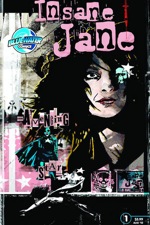 Insane Jane—Avenging Star #1
Insane Jane—Avenging Star #1
Written by Darren Davis & Zach Hunchar
Art by GMB Chomichuk
(Bluewater Productions)
Pull: Absolutely.
Annie says: The best way to explain the premise for this comic is to take Joker, in Arkham Asylum, make him into a girl and less of a villain and you’ve got Insane Jane. Not only is this comic a pretty original plotline, it’s aesthetically maddening which, I think, is the entire point.
This comic stems from a miniseries that is also worth picking up. Jane is a regular woman who wants nothing more than to be a superhero; given the opportunity, she saves an innocent man from a convenience store robbery and creates an alter ego; The Avenging Star. As soon as Jane’s aspiration to become a superhero is obtained, her regular life spirals completely out of control. She’s beaten up verbally and physically, orphaned, and put under psychiatric care in an asylum, which is where this issue picks up.
Jane, who doesn’t sleep, spends most of her days talking to herself and recreating action scenes she encountered during her time as Avenging Star. She’s medicated on a daily basis and keeps to herself, until a new patient arrives, Grant. Grant comes in and suggests that he and The Avenging Star team up and break out of the asylum together. In a classic comic book manner, they do just that. The plot is original and well done. The rants that Jane goes on while alone are manic and perfectly convey that feeling to the reader; there should be no question in your mind that Jane is crazy because she is, in fact, absolutely insane.
The real focus of this review, though, is on the artwork used. It looks like a series of stock image backgrounds with classic depictions of the super villains that Jane fights. You can see the indentations on the paper and it has a great scrapbook feel to it. Saying it has a scrapbook feel almost diminishes how truly original it is, though. I took the time to dig through some of GMB Chomichuk and his style of illustration truly brings the stories he illustrates to life. In the case of Insane Jane, I am positive it could not have been done any other way; it is an absolute perfect match. I can’t find a whole lot of information about him but anyone who knows his work (or how to pronounce his first name?) should spread the information because not only is he talented but he’s doing great things for comic education.
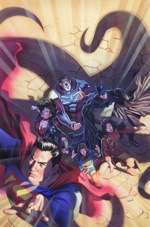 JLA/The 99 #1 (of 6)
JLA/The 99 #1 (of 6)
Written by Stuart Moore & Fabian Nicieza
Art by Tom Derenick & Drew Geraci
(DC Comics & Teshkeel Comics)
Pull: Maybe. Depends on the audience. The younger the better.
Chris says: Do you know who The 99 are? According to a particularly goofy article by the New York Post’s Andrea Peyser, they are a MUSLIM PROPOGANDA EFFORT here to TAKE YOUR BABIES FOR ISLAM. In reality, they’re just another superhero team and don’t represent a viewpoint much beyond inclusiveness regardless of race, religion, or nationality. (Carole Cadwalladr has a great rundown of the origins of The 99 at The Observer.)
In JLA/The 99 this approach is refreshing. There’s no controversy, no soapboxing, just a couple of big superteams beating up bad guys and saving innocents. The comic does get a little heavy on keeping everyone buddy-buddy, but other than that it’s just your standard team-em-up-and-beat-em-up.
Somewhat because the book is devoid of controversy, it’s a bit boring. The book is written for a young audience, though, and I imagine someone just getting into superhero comics would have a great time with the introduction of these new characters and powersets. (They’d also forgive a very uncharacteristic thing Superman says near the end.) This issue, along with this mini-series, is a good toybox for firing up the imaginations of young readers.
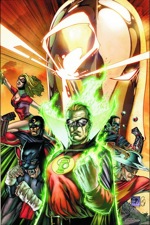 The Justice Society of America #44
The Justice Society of America #44
Written by Marc Guggenheim
Art by Scott Kolins
(DC Comics)
Pull: No. The potentially interesting developments are in the next issue, most likely.
Chris says: This one doesn’t fit in the rack quite right. This issue marks the beginning of writer Marc Guggenheim’s run on The Justice Society of America, but if often feels like the characters don’t belong in the story Guggenheim is telling.
That story itself is fairly straightforward. A speechless villain (a genuinely scary-looking figure detailed and designed by artist Scott Kolins) escapes from a CIA black prison in Afghanistan and attacks Washington D.C. He is immediately labeled a terrorist by the Justice Society and here is where the title starts to step away from the reader. The villain certainly acts like a terrorist, bringing down buildings and causing a large amount of mayhem, but then again…so does every superpowered being in the DC Universe. There’s nothing in the villain’s actions or the viewpoint of the main characters that gives us a reason for the bad guy to be separately delineated as a terrorist and not a supervillain. Guggenheim’s hand is too obvious here, and it throws you out of the story.
There is a reason why the subject of terrorism comes up in this issue, as the Justice Society ends up causing far more damage than the villain does and this does not go unnoticed. The idea of collateral damage caused by superpowered individuals being considered terrorism is an interesting one to follow, but I’m not convinced that this is the book to do it in. For one thing, this concept seems blind to the social status and privilege the main characters operate under. The Justice Society is comprised largely (though not entirely) of esteemed white men who are considered legacy heroes. Having the U.S. government label them as terrorists stretches credibility in both a realistic sense and within the fictional context this title operates in.
It’s very possible that Guggenheim is going to address all of this in upcoming issues, but for now this comes off as an interesting concept trapped in the wrong book.
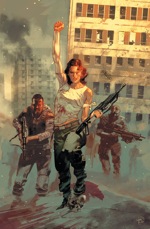 Terminator: 1984 #2 (of 3)
Terminator: 1984 #2 (of 3)
Written by Zack Whedon
Art by Andy MacDonald
(Dark Horse Comics)
Pull: Certainly; this continues to be one of the best Terminator tales since Cameron stepped away from the series in the early ’90s.
Matt says: Another issue into Whedon and MacDonald’s second Terminator series, and still no clear sign as to what we’re in for. Will this be a Terminator tale that finally takes back the original theme of the series (“No fate but what we make”)? Or will it be another elaborate ret-con designed solely to shore up cracks and close the inexorable loop between past and post-apocalyptic future? On the one hand, we have lovable Whedon creation Ben; we have a brand-new Terminator for this issue; and we have the stunning retcon of Kyle Reese’s survival of the events of the first film. All of this leads us to hope, along with the cast of protagonists, that the future really can be changed.
On the other hand, Whedon can’t help but give little winks to what has come before; last month’s issue #1 explained a lingering plot-hole in the first movie (how did the cops and ambulances get there so fast?), while this month’s issue explains a lingering plothole from the second flick (why was so little of the first T-800 recovered as a basis for Miles Dyson’s research? What happened to the rest of it?). Each time, Whedon seems to offer us with one hand (a retcon that allows for a new future and a new development—in a word, freedom) what he takes away with the other (this “new” past had to have happened in order for the films you’ve already seen to turn out as they did—in a word, destiny). Will this be a bold re-launch (à la J.J. Abrams’s Star Trek), or an elaborate mousetrap (à la Terminator: Salvation)?
Fortunately, 1984 is still engaging enough as a tale that I’m going to stick around to find out. Whedon’s characters are still compelling and well-written, and Andy MacDonald continues to prove that I was wrong to dismiss him so quickly back in his NYC Mech days. (I know, I know—lots of you liked that series…) MacDonald’s pacing, storytelling, and action sequences are all compelling here (with the sole exception of a disappearing garbage truck on page 16—but we’ll let it slide), and best of all he and Zack Whedon deliver 24 pages of story for 50 cents less than you’re going to spend on any 22 of Marvel’s or DC’s this month.
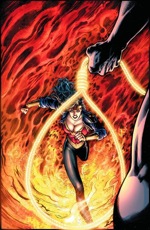 Wonder Woman #604
Wonder Woman #604
Written by J. Michael Straczynski
Art by Don Kramer & Eduardo Pansica
(DC Comics)
Pull: No. If you’ve read issue 600 already, then you’ve got all the Wonder Woman you want until this story arc finally starts to go somewhere…
Matt says: JMS sure does love an alternate continuity, doesn’t he? You’ll have to admit, though, that one kind of sees his point when it comes to the big, flagship characters of the DC and Marvel Universes. For too long, the Big Guns have been sacred cows; you can tell stories about them, as long as nothing really changes. Umberto Eco, writing about Superman, noticed this basic “temporal paradox” back in 1962: on the one hand, these iconic heroes must act in order for there to be stories about them; but on the other hand, they cannot really act in the way that you or I do, for this would both change them and bring them one step closer to death. And so instead, we get a perpetual recycling of “now,” a mythic cycle in which the notion of time itself must be intentionally confused. (Hence, you could say, the perpetual “Crises” that plague both the Marvel and DC Universes…) What we’ve finally seen in the last ten years, of course, is a slow easing of this policy; Big Name Authors have been allowed to come in and make Big Changes to characters—though in the end, of course, the status quo seems to be like a rubber band, and the harder you pull it, the harder it snaps back on your fingers. This painful “snap” has acquired a name over the years: J. Michael Straczynski. While the Spider-Man books are still recovering from this status quo snap, JMS is getting his hands dirty playing in DC’s sandbox these days with two continuity-altered Big Guns: Superman (over in the Superman: Earth One graphic novel, also on stands today) and Wonder Woman.
By now, even if you’re not reading Wonder Woman, you’ve seen pictures of the new costume, designed by once-and-future comics legend, Jim Lee. Gone is the boots-with-bathing-suit look, and a younger-looking Diana now runs about in leggings and a jacket (a look not so very far from Jim Lee’s take on Rogue back during his name-making X-Men days…). The outfit change has had its defenders and its detractors, and I tend to see both sides of the issue here. But the big point, as I take it, is not behind all of the changes. Wonder Woman had, over the years, “become, for lack of a better word, stuffy,” Straczynski wrote back in August’s Wonder Woman #600. “It seemed to me that the only way to address the situation and turn the character around was to go in prepared to make massive changes in how we think about Wonder Woman…. We had to be bold.” The question, then, is: are the changes working? Is Wonder Woman less stuffy? Less grandmotherly? More of the ass-kicking, flirty, feminist icon she ought to be?
Well…not yet. On the one hand, the alternate continuity gesture has been brilliant; sweep away any and all history for the character, and build a 21st-century Diana on clean ground. But alas, having cleared that ground, JMS has so far left the new character pretty blank. Wonder Woman seems younger and less experienced—which means that much of her majesty and poise has disappeared as well. But instead of replacing that majesty and poise with vulnerable complexity and the fresh, often paradoxical voice of young, 21st-century feminism, JMS has largely just let Diana bounce off of things for the last few months. She’s slowly acquiring the trappings of the classic Wonder Woman—but there seem to be too many battles ended through deus ex machina (a Cerberus who falls asleep; a ghostly mother who steps in with a sword…), and too many obstacles simply wandered past. We’ve felt very little character development so far—and so at this point, we seem to mostly just have Wonder Woman without the Wonder Woman…
Meanwhile, Don Kramer and Eduardo Pansica continue their tag team on the art chores this month; the storytelling is passable, but the composition and pacing leaves a lot to be desired. If you ever felt like the Dodsons were just a poor man’s Adam Hughes, you’re still surely missing them now. Overall, it feels like DC pulled the punch on their relaunch, here. At a time when Darren Star is rumored to be trying to bring Wonder Woman back to television, Jim Lee steps in to help with the most radical character redesign in her almost 70-year history, and the book has just hit its landmark 600th issue, the time feels ripe for a Wonder Woman book that will blow you away. At this point, though, I’d just settle for one that will bring me back.
When Matt Lampert isn’t writing about comics, he’s a philosophy professor in New York City.
Annie Gala has been consumed by yellow duct tape and cape hemming.
Chris Greenland once played chess with Death, took a bathroom break, and never came back.










